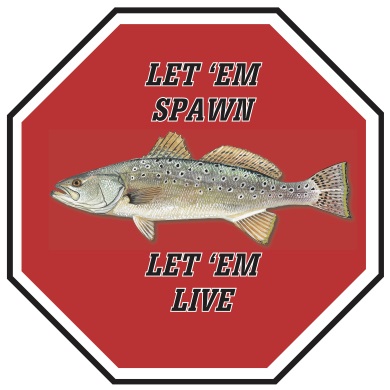DNR News
SCDNR urging catch and release to help spotted seatrout recover January 18, 2018
Unusually cold weather has gripped South Carolina this January, lowering water temperatures along the coast to levels that can be deadly for many marine animals. As South Carolina Department of Natural Resources (SCDNR) biologists work to understand the severity of this winter weather's impacts on important fisheries, they're also asking the public to help – by practicing catch and release of spotted seatrout, one of the fish hardest hit by the low temperatures.

Spotted seatrout is the second most popular gamefish species in South Carolina.
After a rapid and steep decline in December, water temperatures across the coast plummeted in early January. Charleston Harbor experienced a daily average low of 42 degrees Fahrenheit on January 7, while shallow tidal creeks reached even lower. While unusual, these temperatures are not unprecedented – currently the 2017-2018 winter ranks as the coast's fifth coldest since recordkeeping began in 1950. However, two months of winter remain, and the lower and longer the duration of low temperatures, the greater the potential damage on fisheries.
Sustained water temperatures below 48 degrees can injure or kill many marine animals, and shortly after the first week of January, SCDNR staff and members of the public began reporting dead fish and shrimp along the shores of tidal marshes and saltwater impoundments across the coast. The agency acted quickly to protect surviving white shrimp by closing the shrimp trawl season.
"White shrimp are prolific spawners and can recover relatively quickly," said David Whitaker, deputy director of the agency's Marine Resources Division. "It's too soon to assess the prospects for the 2018 fall fishery, but with some modest survival of spawning stock, it is still possible to have a relatively good fall fishery. We'll be assessing the spawning stock over the next several months."
Members of the public have reported numerous species of fish killed, including mullet, red drum, spotted seatrout and sheepshead. While SCDNR biologists will monitor all of these species in the coming months, they remain most concerned about spotted seatrout. Spotted seatrout are the second most popular recreational fish in South Carolina, and they're particularly vulnerable to low water temperatures. Because these sub-tropical fish spend their entire lives in coastal rivers and estuaries, unlike red drum or sheepshead, low temperatures can kill seatrout of all ages – including large adults that contribute the most eggs to each new generation of seatrout.
SCDNR biologists operate two monthly fish surveys across the South Carolina coast – the trammel net and electrofishing surveys – that track the health of spotted seatrout (among many other estuarine animals) and will help determine the severity of the winter's impacts. By April 2018, the spawning seatrout that have survived this winter will have shown up in these surveys, giving biologists a preliminary idea of how the population fared. Staff expect to have a more complete understanding of the impacts on the entire population by late summer.
As a precautionary measure, the SCDNR is asking anglers to practice catch and release of all spotted seatrout through the end of September.
"Seatrout numbers have been above average in South Carolina in recent years," said agency spokesperson Phil Maier. "We hope that strong starting point, combined with voluntary conservation efforts by anglers, will help the fish recover quickly."
Spotted seatrout suffered cold winter kills in 2010-2011, 2009-2010 and 2000-2001. Voluntary catch and release was encouraged after these winters, and full recovery took several years in each case.
SCDNR biologists expect to see fish kills for some time and continue to welcome all public reports. Sightings of dead or lethargic fish can be reported to SCDNR scientist Dr. Joey Ballenger at BallengerJ@dnr.sc.gov. Please include detailed information about the location, date, species, and number of animals seen.
DNR Media Contacts
| Area | Personnel | Number |
|---|---|---|
| Coastal | David Lucas | 843-610-0096 |
| Marine | Erin Weeks | 843-953-9845 |
| Midlands | Kaley Nevin | 803-917-0398 |
| Upstate | Greg Lucas | 864-380-5201 |
After Hours Radio Room - 803-955-4000
